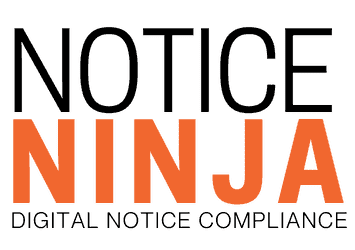Yes, NOTICENINJA is corporate tax notice compliance software that automates key workflows including notice assignments. The platform employs a rule-based system that can manage multiple level rules and ensure notices are directed to the appropriate stakeholder. As a result, you’ll never have to worry about notices being misdirected or slipping between the cracks.

The Compliance Risk Hiding in Your Tax Inbox

13 November
Why This Problem Gets Ignored Until It’s Too Late
Across enterprise organizations, tax leaders keep running into the same conversation.
They’re tracking notices in their email portal. They’re relying on a shared folder for state-level mail scans. They’re naming files based on memory and hoping someone follows up.
We hear it all the time when talking with compliance heads, operations managers, and VPs of tax. These leaders aren’t resistant to change. They’ve had to build workarounds when the tech they had couldn’t flex to how they really operate.
This post digs into why that problem persists, how it’s showing up inside tax teams today, and what the 2025 Corporate Tax Department Technology Report: Taking the Initial Steps Toward a Tech-Enabled Revolution, published by Thomson Reuters and the Tax Executives Institute (TEI), reveals about what needs to change.
Where Most Tax Workflows Begin (and Stall)
The first mile of tax notice management rarely begins with a structured system. Intake isn’t treated as a workflow; it is just the step before the real work begins.
That is also where risk quietly enters the process.
If intake isn’t structured, neither is response. Teams end up prioritizing based on who opened the notice first instead of what the notice requires. Follow-up becomes manual, tracking grows inconsistent, and audit trails scatter across inboxes and folders.
This approach might work for a small team handling a few notices. It cannot scale across entities, jurisdictions, and reporting cycles. What looks like a process is really a patchwork, and it unravels quickly when volume rises or roles shift.
Why the Inbox Bottleneck Persists
According to the 2025 Corporate Tax Department Technology Report, 65% of tax departments still receive notices by mail or scanned PDFs sent via email. But when you realize that 56% of respondents also say their tools don’t integrate with other systems, its easy to see, there's a problem. In some cases, email, spreadsheets, and shared drives are still considered the “system” which paints a different picture. The big eye-opener is many leaders list efficiency as a top technology goal.
The data tells a clear story. The industry knows what it wants, but it hasn’t been equipped with systems that support the first part of the job.
“I feel that there’s no reason to be doing processes manually when there are alternatives to automating them. Human review and intervention will always be needed, but I believe that 90% of the upfront work can be accomplished more efficiently by making use of available technologies.”
That upfront work starts when the document hits your system. Yet in practice, that crucial starting point is a gap in the process.
Manual Intake Isn’t a Process. It’s a Patch.
Despite being labeled as “systems,” these ad hoc methods (drives, templates and tribal knowledge) do not represent an intentional intake framework. The process is rarely structured, leaving tax teams without true visibility or standardized accountability from the start.
But these manual tools weren’t made for this. They were made for sharing files, not for tracking accountability. They’re brittle, hard to audit, and easy to overlook especially when volume spikes or teams shift.
It’s no surprise that tax operations are struggling to scale. You can’t move faster, or with efficiency, when your first step is a bottleneck.
What Happens When Intake Is Built With Intent
The solution doesn’t begin with dashboards. It starts with systems that reduce the margin of error at the beginning. That moment when a notice is scanned, emailed, or uploaded.
That’s where modern intake solutions make the biggest difference. By transforming raw documents into structured, categorized, and assigned actions, they eliminate the risks caused by guesswork, rework, or unclear ownership.
Think of it like air traffic control for your tax team. Every document is tracked, identified, and cleared for resolution with no manual tower needed.
This isn’t just about automation. It’s intelligence applied exactly where it matters, using technology to drive dependable, scalable outcomes from the first step.
If It Starts in the Inbox, It Ends in Delay
An inbox may be the easiest place to receive a notice. It’s also the easiest place to lose track of one.
That lost time isn’t just operational drag. It’s financial exposure. Missed deadlines, incorrect responses, and slow audits all trace back to the same origin. No structure at the start.
Tax departments who want to scale need to stop solving downstream problems with upstream blind spots. It’s not about removing humans from the process. It’s about removing the drag that leads to operational risk.
A Better Way Forward Starts at the Beginning
You don’t need more spreadsheets or better naming conventions. You need a system that absorbs volume, flags priority, and removes the manual lift where it doesn’t belong.
That’s why we built NOTICENINJA to address the unique challenges of tax notice management from the very first step. Our platform does that right at the beginning with intelligent OCR (Optical Character Recognition) intake, powered by AI, so nothing gets lost, delayed, or misclassified at the source.
If your team is still managing notices through email and folders, it’s time to rethink the first mile of your process.
Download our Tax Notice Compliance Readiness to see how your compliance and intake systems measure up and what needs to change to reduce risk and improve speed.
Get the Tax Notice Compliance Readiness Tool.
RELATED POSTS
- Reclaiming the Compliance Mailroom: How to Automate Document Intake and Eliminate Risk
- Why Notice Automation Needs More Than an Inbox
- Tax Notice Compliance Starts with the Scan
